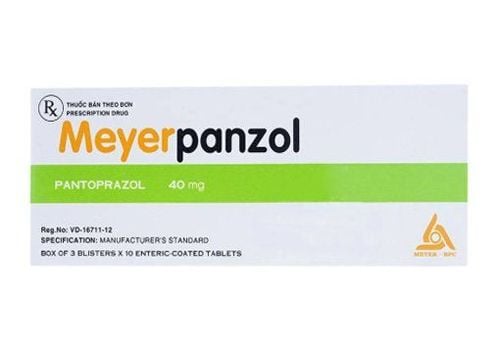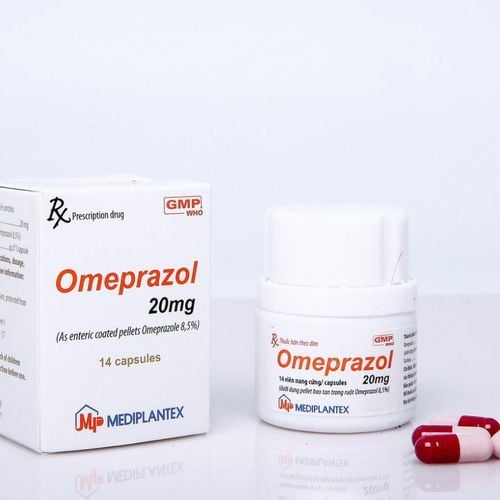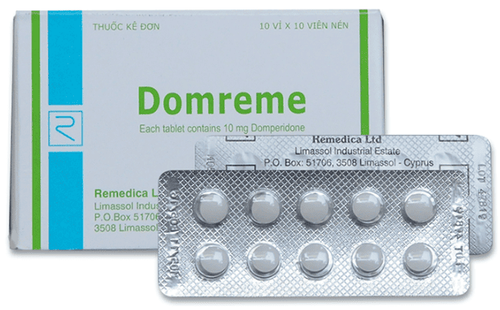This is an automatically translated article.
Aciloc 300 is an antihistamine with the main ingredient Ranitidine. The drug is used in the treatment of benign peptic ulcers, gastric mucosal lesions, chronic dyspepsia or prophylaxis before general anesthesia... Here is detailed information about Aciloc 300: What drugs and precautions when using.
1. What is Aciloc 300?
Aciloc 300 has the main ingredient Ranitidine, a histamine receptor antagonist. Aciloc 300 is used in the treatment of diseases:
Benign peptic ulcers, including cases caused by non-steroid anti-inflammatory drugs, postoperative ulcers, reflux esophagitis, Zollinger Ellison syndrome ; Duodenal ulcer caused by Helicobacter pylori bacteria; Chronic dyspepsia, characterized by pain (epigastric and sternum) associated with meals or insomnia; Damage to the gastric mucosa (erosion, bleeding, edema in acute gastritis, acute progressive stage of chronic gastritis); Prophylaxis before general anesthesia in patients at risk for acid aspiration (Mendelson's syndrome), especially in pregnant patients in labor. Ranitidine reduces the amount of gastric acid secreted both day and night, in a state stimulated by food, insulin, amino acids, and histamine by competitively inhibiting histamine at the H-receptors of the parietal cells. The inhibitory effect of ranitidine on gastric acid secretion is 3-13 times stronger than that of cimetidine, but side effects are less.
The bioavailability of Ranitidine is about 50%, oral administration after 2-3 hours will reach maximum plasma concentrations, absorption is almost unaffected by food and antacids. The parenteral route captures peak plasma concentrations more rapidly, within 15 minutes of injection.
2. Dosage and how to use Aciloc 300
Aciloc 300 for oral use, the subject of use is people 12 years of age and older.
For benign peptic ulcer: In the acute phase, 150mg x 2 times/day or 300mg at bedtime. Usually, ulcers heal in 4 weeks, ulcers caused by NSAIDs are 8 weeks, some can last longer. After ulcer healing, maintenance treatment is 150mg before going to bed. For GERD: The usual dose for adults is 150mg x 2 times/day or 300mg at bedtime, used continuously for 8 weeks. In severe cases, the dose can be increased to 300mg x 4 times/day. Duodenal ulcer with H. pylori infection: Use 150mg x 2 times/day or 300mg at bedtime, in combination with Amoxicillin 750mg x 3 times/day and Metronidazol 500mg x 3 times/day for 2 weeks. Then continue treatment with Aciloc 300 for 2 weeks. Zollinger-Ellison syndrome: Initial dose 150mg 3 times/day, increase dose if needed, up to 6g/day as directed by physician. Gastrointestinal ulcers and bleeding: If the cause is acute gastric mucosal injury, parenteral therapy should be initiated. Otherwise, the oral dose is 150mg x 2 times/day. Impaired renal function: The recommended dose for individuals with creatinine clearance less than 50ml/min is 150mg daily at bedtime, the dose may be increased every 12 hours but requires extreme caution, hemodialysis may decrease circulating levels of ranitidine. Postoperative ulcer: The recommended dose is 150mg twice daily for 4 weeks. Prophylaxis of Mendelson's syndrome 150 mg of Ranitidine before anesthesia. To reduce stomach acid in obstetrics, take 150mg at the time of labor, then every 6 hours. Indigestion: 150mg twice a day, continuously for 4-6 weeks. Note: With dose < 300mg, the dosage form of 300mg film coated tablet is not suitable for dividing dose, but should refer to using 150mg dosage form.
3. Contraindications Aciloc 300
Aciloc 300 is contraindicated for people with hypersensitivity to Ranitidine and other components of the drug.
4. Be careful when using Aciloc 300
Treatment with H histamine antagonists can mask the symptoms of gastric cancer, delaying the time to diagnosis. Therefore, when gastric cancer is suspected, an exclusion test should be performed before starting treatment with Aciloc 300.
Aciloc 300 is eliminated by the kidneys, so in people with severe renal impairment, drug levels in the blood future will increase. Therefore, monitoring and dose adjustment is necessary in these patients.
For pregnant women, there have not been many studies in this subject, studies in rabbits and rats have not revealed any effects in the fetus. Therefore, you should only use the drug as directed by your doctor when absolutely necessary after weighing the benefits.
For breastfeeding women, Aciloc 300 can be excreted in milk, so it should only be used under the direction of a doctor when absolutely necessary.
5. Drug interactions
Possible interactions when using Aciloc 300 with some of the following drugs:
Little effect on the liver metabolism of some anticoagulants Cumarin, Theophyllin, Diazepam, Propranolol. Almost no effect when used in combination with Quinolone antibiotics with H antagonists. Reduces absorption of Ketoconazole, Fluconazole and Itraconazole because Aciloc 300 reduces the acidity of the stomach. Co-administration of Theophyllin with Ranitidine, the serum Theophylline concentration and toxicity increased very little. Co-administration of Ranitidine with Clarithromycin increased plasma concentrations of Ranitidine (57%). Propanthelin bromide increases peak serum concentrations of Ranitidine and slows absorption. Administration of Ranitudin with food or with a low dose of antacids did not show decreased absorption or peak plasma concentrations of Ranitidine.
6. Side effects of Aciloc 300
Results from clinical trials show a 3-5% incidence of side effects with Aciloc 300. Specific:
Common: Headache, dizziness, weakness, diarrhea, erythema. Uncommon: Leukopenia, thrombocytopenia, pruritus, injection site pain, transaminase elevation. Rare: Urticaria, bronchospasm, anaphylactic shock, angioedema, myalgia, arthralgia, agranulocytosis, pancytopenia, bone marrow hypoplasia, bradycardia, hypotension, block atrioventricular, systolic failure after rapid injection, gynecomastia in men, pancreatitis, erythema multiforme, hepatitis, eye accommodation disorder.
7. Treatment of overdose
Usually, there are no serious problems with Aciloc 300 overdose, so there is no specific antidote. Some drugs to support symptom relief such as:
Diazepam intravenous to treat convulsions. Atropine treats bradycardia. Lidocaine for the treatment of ventricular arrhythmias. During the treatment of overdose, it is necessary to continuously monitor and minimize unwanted effects. If necessary, hemodialysis can be used to remove the drug from the plasma.
In summary, Aciloc 300 is indicated in the treatment of benign gastric and duodenal ulcers, gastric mucosal lesions, chronic dyspepsia or prophylaxis before general anesthesia... To ensure safety To be safe for health and maximize the effectiveness of treatment, patients need to take Aciloc 300 exactly as directed by their doctor.
Please dial HOTLINE for more information or register for an appointment HERE. Download MyVinmec app to make appointments faster and to manage your bookings easily.













